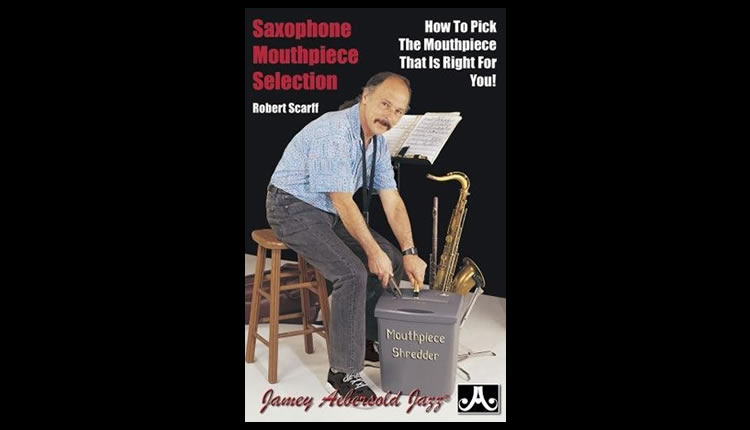Saxophone players obsess about mouthpieces and spend a lot of time and money experimenting to find the “perfect” mouthpiece. I know professional musicians who own 20 or more saxophone mouthpieces, and are constantly searching for a better one.
Robert Scarff’s book is a complete and concise book on the subject. His basic premise is that the sound that a saxophonist projects is the most important aspect of his or her performance and finding the right mouthpiece/reed combination is essential to producing a full, resonant sound.
There are twelve chapters in this 88-page spiral-bound book. The author offers excellent insight into saxophone mouthpiece selection. Scarff writes in a breezy, informal way that is light-hearted, often casual, and his comments are frequently “tongue-in-cheek”.
The author examines the basic concepts of mouthpiece design, such as tip opening, facing length, and chamber size. He comments on how these factors affect tone, response, intonation, volume, and relative brightness, and/or darkness of a player’s sound.
Scarff points out that there has been a steady progression over the years to use wider tip openings, smaller chambers, and harder reeds. This combination produces a bigger and brighter sound that helps the sound to project.
The author analyzes the types of material used in the making of saxophone mouthpieces; (hard rubber, metal, and plastic) the outer shape, chamber size, facing curve, and side and tip rails. He compares characteristics of sounds produced by using a mouthpiece with a smaller chamber and shorter facing length to using a mouthpiece with a larger chamber and longer facing length. He lists the pros and cons of each choice.
My dad was a professional saxophonist and played lead alto with many big bands in the New York area. He played a Buescher alto sax that he bought in the 1930s and used a white Brillhart 3 mouthpiece with a medium Rico reed. He had a warm, crisp, driving edge to his sound. His playing was a lot like that of Marshall Royal, who played lead alto with the great Count Basie band. I am also a saxophonist, so I tried my dad’s mouthpiece and reed on my Selmer Mark VI alto sax and felt it was too stuffy. While I was arranging for the West Point Jazz Knights in the 1980s, the saxophonists in the band urged me to try a Meyer 6 hard rubber mouthpiece with a medium Rico reed. It was perfect for my situation; just the right edge, and I could easily control the tone quality. I wanted to play lead alto and produce an edge to my sound for playing in a big band, and be able to get a sound like Paul Desmond with my jazz trio. This combination of mouthpiece and reed allowed me to do just that.
Scarff discusses saxophone necks and reeds, and their importance to the quality of the sound. He goes on to mention that the reed is the most unstable part of the equation. He even discusses the effect of different ligatures on tone quality. A Reed Adjustment Chart is included that lists common problem areas and suggested solutions.
Recently, I had my Selmer Mark VI repadded and the music storeowner loaned me a new, top-of-the-line alto sax. After practicing about 30 minutes, using my Meyer 6 mouthpiece and Rico reed, I was convinced that the high-end, expensive alto sax had a thin, colorless, anemic tone that lacked the resonance, projection, and richness of my Selmer. My conclusion is that the quality of the saxophone makes the most difference, and you must experiment to find the best combination of mouthpiece and reed to fit the style of music that you are playing.
Scarff includes Mouthpiece Facing Charts that compare various makes of mouthpieces for soprano, alto, tenor, and baritone saxes, as well as for Bb soprano, bass, Eb, and alto clarinets. When I compared my dad’s No. 3 Brillhart mouthpiece with my Meyer 6 mouthpiece, I noticed that the Meyer was given a brighter rating.
The diagrams are helpful, in that they clarify the points made in the book. The author makes many other suggestions for keeping your instrument in proper working condition. He compares end plugs with pad savers, and recommends the use of pad clamps for the proper seating of pads.
This book contains many useful hints for the selection of saxophone mouthpieces, reeds, and ligatures. I highly recommend this book to all teachers as it will provide valuable insight into many areas of the saxophone that are too often ignored.
Book review by Vince Corozine, author of ARRANGING MUSIC FOR THE REAL WORLD, published by Mel Bay Publications.


